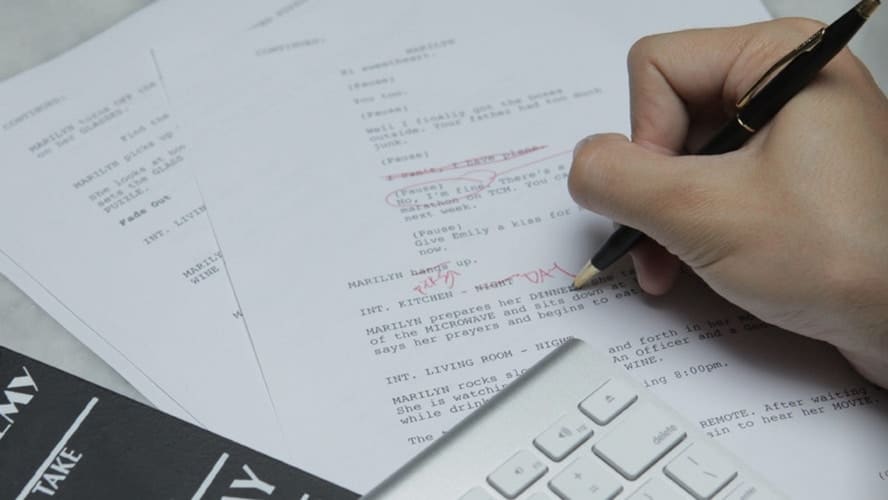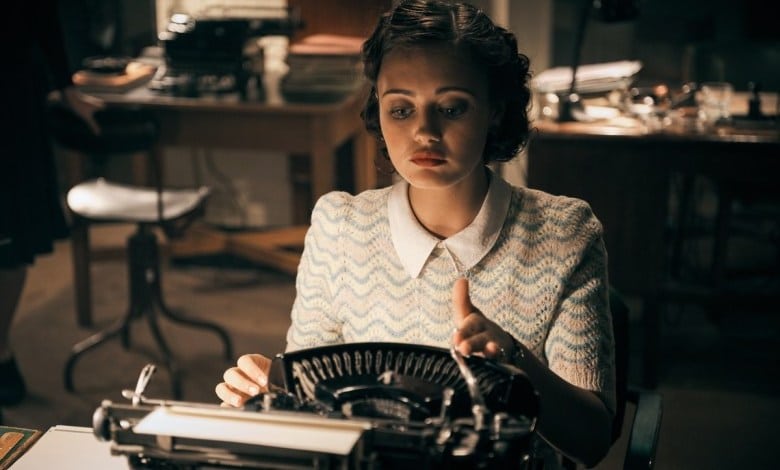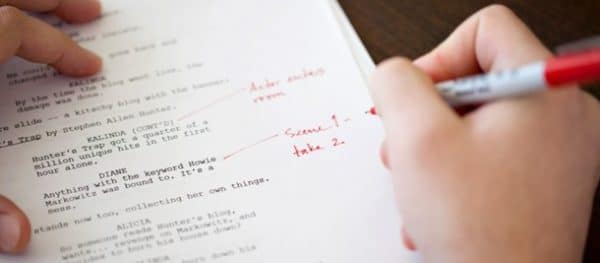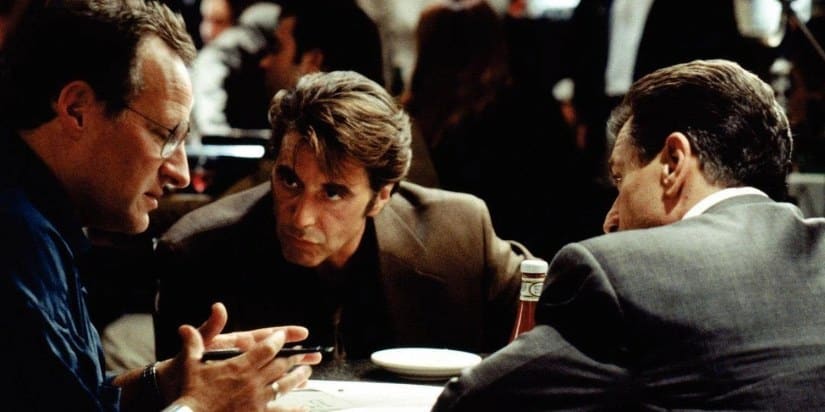We’re all perfectionists when it comes to our writing – whether we want to admit it or not. Developing a writing process that works for you is one thing, but nailing the rewriting process is another challenge.
If you’re at this stage, the good news is you’ve done the hard part: the act of actually writing something. You’ve been hunched over, staring at your laptop for hours on end, drank perhaps way too much caffeine and definitely reconsidered your career choices at least ten times. But you finally have a rough draft!
The bad news, as we all know, is that it’s only the beginning of a long and meticulous scriptwriting process. So, roll back your shoulders and grab another cup of coffee (or something stronger!). It’s time to revisit, rework and rewrite your script.
Table of Contents
What is a Rewrite?
Rewriting is an essential part of editing. It includes going through and strengthening a rough draft by altering what’s in need of improvement. This can range from changing a few words to cutting out entire unnecessary sections.
Ultimately, the rewriting process will polish subsequent drafts and evolve your project to the best place it can be.
Rewriting is when writing really gets to be fun…. In baseball you only get three swings and you’re out. In rewriting, you get almost as many swings as you want and you know, sooner or later, you’ll hit the ball.
Neil Simon
1. Where to Start?
The weight of an unfinished project can be overwhelming. Rewriting is a particularly daunting task. And it can be a little heartbreaking too.
The best thing you can do after completing your first draft is take a step back.
- Leave your screenplay alone for several days, a couple of weeks, or a month.
- Return with a fresh mind and a new perspective.
In the meantime, acquire some honest, objective and constructive feedback on your script from a few trusted sources. A Script Doctor or Script Editor could be particularly helpful with this. Another set of eyes will be enlightening and can pick up on aspects you might have missed.
Whilst it’s difficult not to feel protective over your own work, other opinions and interpretations will only help it improve. They’re not only desired, they’re essential.

2. Become the Reader
The next step of the rewriting process is re-reading it yourself.
WARNING: Reading back your own work may unearth cringe-worthy feelings, including embarrassment, mortification and complete humiliation.
Be brave.
Unless you are the most polished writer the world has ever seen, it’s highly likely your self-esteem will have taken several hits in the feedback process. But don’t give in. Besides, no one can tear you down better than yourself. So, once you’ve gotten past the initial discomfort, pick apart your first draft like it’s one of those dull classic novels you were forced to analyze in English class.
- Go through your work intensively.
- Make comments on the document, or jot it down on paper.
- If you can print out the full script, sometimes having a physical copy can help focus your mind (it also makes you less likely to accidentally skim read!).
You could use colour coding to determine which parts you need to focus on.
- If you’re particularly unhappy with a certain description or line of dialogue, highlight it in red.
- If you’re not quite sure about something and think reworking would benefit it, underline it in yellow.
- This is a good visual stimulus to help order your thoughts and figure out the strengths and weaknesses of your script.
It’s important you don’t focus too much on what’s ‘wrong’ with the draft. Be kind to yourself. Try to maintain a positive mindset. It’s challenging to overcome self-doubt, but attempt to ignore that devilish inner critic in your head – it’s mostly talking from fear.
Overpower those feelings by finding joy in your creative process again. Celebrate the little wins. Think about how great it’ll feel when you finally nail the scene that’s been tormenting you for weeks!

3. Breaking Down Each Scene
Be honest with yourself…
- Does each scene, character and dialogue have a purpose?
- Are they serving the story; driving the plot and characters forwards?
- Have you threaded your themes seamlessly throughout the narrative?
Go through your script and remind yourself of your intentions. Think about how each scene contributes to the overall story.
A helpful exercise is writing a one-sentence breakdown for your scenes.
- Check that the overarching plot in its simplest form is clear.
- Ensure the premise is easily established early on.
- Consider if any scene orders should be tweaked.
It’s easy to get caught up in exciting new ideas and subplots when you’re first writing, so make sure you maintain focus now. If you notice you’ve gone a bit rogue, the rewriting process gives you the chance to set yourself back on course.
Trust your writing instincts. If a scene has flagged up as unimportant, isn’t flowing or just doesn’t seem quite right, make a note of it – there’s likely a reason you feel that way. You might not know it at first, but with time you will hopefully be able to source the reason for its discomfort.
Be ruthless. It might be soul-destroying to press that delete button, but it’ll ensure your script improves.
- Again, cut out anything unnecessary, especially backstory – over-explaining is the easiest trap to fall into when you’re pouring out ideas in the first draft.
- Be wary of how much information is actually needed. There may be some scenes, characters and actions that can be eliminated entirely. Others might need reshaping, to be combined or to move elsewhere.
- Interrogate your scenes and locate the root cause of any problems. Sometimes there’s just a little spark lacking. If you’re dealing with a stubborn scene, is there a way to evolve it into becoming more memorable? It could be as simple as changing the location, adding characters or redefining their goals.

4. Conflict is Key
Conflict is key. Every story needs it to propel the narrative forwards.
- Are your stakes high enough and escalating?
- Are there problems needing to be solved?
- What obstacles are preventing the characters from achieving their goals?
Bullet point the main obstacle(s) in each scene. Remember that conflict should not only exist at the individual scene level, it has to be layered in throughout. If you notice during your rewriting process that the script is feeling a little thin, this might be why.
Visualize your screenplay on a table in front of you. Imagine there’s a camera zooming in and then panning back out again. Scrutinizing your script line by line and honing in on individual elements is important, but you also have to remember to see the screenplay as a whole too.
- How is the pacing?
- Does the action build in a way that fits the overall story structure?
You could make a graph pinpointing where the dramatic points occur throughout. This will visually demonstrate the trajectory of how the tension builds. It’s a particularly useful exercise that will show you whether there are scenes or plot points that need to be reshuffled or readjusted during the rewrite.

5. Character Rewrites
Remember what will draw audiences in. The plot, of course, has to be solid and interesting. But audiences also need compelling, enticing and diverse characters they can enjoy. This will attach them emotionally to the story.
- What qualities do your characters have that the audience can understand, empathize or connect with?
- Have you fleshed them out and given them enough substance?
- What do they bring to the table? Justify their existence in the story. If your script is feeling a little bloated, consider whether any characters can be cut or combined into one personality.
If you haven’t already, make an individual character sheet, noting down their traits and purpose. If you did this before initially writing, revisit it – is there anything you forgot or left out that might now benefit the story?
- Re-familiarize yourself.
- Interrogate your characters. Get to know them even better.
- Examine their relationship to the story and contributions to driving the narrative.
- Are there any interesting untapped dynamics?
It can be fun to play around with dynamics as sometimes unexpected ideas or pairings appear – we see this on screen all the time. Think Monica and Chandler in Friends, their romance came seemingly out of nowhere, catching both them and the audience by surprise. But their relationship quickly became a fan favorite and benefitted the show.
You can always dig deeper and discover more about your characters. Therefore, if any of them are feeling a little flat, the rewriting process is a perfect time to enhance their depth.

6. Protagonists
Give your protagonist the most attention.
- Are you definitely focusing on the right character?
- Do they best serve the plot?
Long-standing television shows often end up switching protagonists part way through their run. The Walking Dead is well known for ruthlessly killing its characters and reshuffling the show’s dynamics.
- For instance, the character Daryl Dixon was famously intended as a guest spot, who would soon meet a grizzly demise.
- However, he was loved so much by audiences that he became a central character, with the main protagonist focus adjusted to him in later seasons.
Thinking about your screenplay as a whole:
- Does your protagonist have an interesting journey?
- Do they meet their aims and objectives by the end?
- Can you squeeze something out about them from each scene?
Look back at your scene breakdowns again.
- Track the turning points in the plot and consider how these changes impact your character.
- Chart the important parts of their development and how this influences the plot/the plot influences them.
- Consider how high the stakes are for your protagonist. If you notice you’ve given them a skillset to easily overcome anything thrown at them, then there’s no conflict or clear journey carved out.
Make sure your characters matter.

7. Rewriting Dialogue
Dialogue is often the bane of most writers’ existence. It’s tricky to create realistic and entertaining speech that retains the natural style of real life. When your ideas are first pouring onto the page, you likely won’t be thinking too much about how it sounds. And that’s okay. It’s better to just get it down. The rewriting process is where you refine it.
- Start by reading the speech in your head.
- If you’ve taken some time away from this project, note whether it still flows the way you intended it to.
- Does it feel natural? Or do your characters sound a bit like robots doing an absolutely terrible job of blending in with normal human behaviour?
Next, read it out loud – either to yourself or with somebody else. Your natural flow will help you recognize whether you need to cut some speech out or readjust any awkward sentence structures.
- Are your characters speaking like they’ve just swallowed a dictionary?
- Is it better to use slang in certain instances?
- If you’re writing a character from a different era you haven’t lived through, consult someone who has and can help refine the dialogue as more realistic.
- If you’re an adult writing a teenage character, talk to someone younger.
Speech patterns are constantly changing. Different words with new meanings pop up all the time and it can be difficult to keep up. For instance, never assume you’ve finally got the grasp of writing realistic teenage slang – nobody ever will!

8. Exposition
We writers seem to love bogging down our work with unnecessary backstory and exposition. Sometimes without even realizing it. The easiest trap to fall into (and almost everyone does it initially) is to rely on dialogue as a way of showing and not telling.
When you read back through your screenplay, obvious attempts of integrated exposition will jump out and you’ll probably question why you even felt the need to add it in.
- Remember to be brutal – the delete button is your friend. If it’s unnecessary or repetitive, cut it. The rewriting process should make a huge difference in cleaning up your dialogue.
- For what needs to be included, consider where else it can be placed in the script that might be a better fit.
There’s a fine line between offering your audience enough information and over-explaining. It’s important to keep people engaged and following along, having them actively participate. Instead of being completely on the nose, drip-feed your audience subtle hints.
Remember where the magic is – saying a lot with a little. You can almost always tighten and sharpen your writing, allowing for more space.
If you’ve recognized there’s too much telling happening, for instance, in your character descriptions and actions, then dialogue might actually become your saving grace. Have a look at how your characters express themselves in speech.
- Are their voices consistent?
- Does it match with their tone, with everything else we know about them; how they react and why, their motivations, their ethos?
- You can reveal a lot through what they say. What’s their choice of language? Do they use big words? Do they muddle words up? Are they quiet, or shy? Do they swear often?
- Revisit the traits on your character sheets and think about how you can feed these into the dialogue.

9. The Simple Things – Spelling, Grammar, Punctuation
Amidst all the structural and word level changes, it’s easy to forget the simple things – spelling, grammar and punctuation.
- Leave it until the end of your rewriting process, but remember to go through and iron out any mistakes in these areas, including screenplay formatting.
- If you’ve read over your work a million times, it can be difficult to pick up on such minor errors. Having a fresh pair of eyes looking over it will assist in spotting these issues.
- Additionally, you could try changing the font to help your mind focus on something you’re not used to.
It might seem a minor thing for a screenplay reader to pick up on and ultimately if your script is working in other areas you may get a pass. However, at the same time, a screenplay with messy spelling, grammar and punctuation can come across as sloppy and unprofessional.
10. One Thing at a Time
When you rewrite, try doing it in smaller bursts rather than tackling everything at once. Otherwise, it’s far too easy to miss things. Moreover, you run the very easy and well-known risk of feeling so overwhelmed you can’t stand the sight of your own writing.
- Take short breaks. Walk around. Eat. Drink water. Do all the little things you forget about when you’re hunched over the computer in writer mode.
- Additionally, if you like to be organized (and also want to procrastinate actually rewriting!) draw up a schedule for your rewriting process; focus on revisiting structure one day and dialogue the next.
- If it gets to that time and you decide you’d rather flesh out your characters instead, simply switch things around. Go with what feels right whilst maintaining a block for every aspect.
The beautiful part of writing is that you don’t have to get it right the first time, unlike, say, a brain surgeon.
Robert Cormier
Remember – complete perfection is impossible. Do not strive for something unattainable.
Be patient. Set realistic goals. Celebrate your creativity.
Most importantly, trust in yourself and your process. Without a structured process to fall back on rewriting can seem overwhelming. But with it, it becomes manageable and ultimately a step to creating an effective screenplay.
–What did you think of this article? Share It, Like It, give it a rating, and let us know your thoughts in the comments box further down…
– Struggling with a script or book? Story analysis is what we do, all day, every day… check out our range of script coverage services for writers & filmmakers.
This article was written by Molly Hutchings and edited by IS Staff.
Get *ALL* our FREE Resources
Tackle the trickiest areas of screenwriting with our exclusive eBooks. Get all our FREE resources when you join 60,000 filmmakers on our mailing list!


Excellent tips for anyone who is struggling to rewrite their second draft.
I’ve saved it in my downloads to revisit it everyy now and then to keep me focussed.
Thanks
Regards
VIJAY
Thanks for the advice on rewriting. Good stuff!
Excellent.
I’ve read dozens of articles about Rewriting but this stands out head and shoulders above the others.
A superb piece of writing that I will use as my bible.
Brilliant work – thank you Molly.
Excellent insights. Having Just finished one I feel reinforced I was doing what was advised👍😎
The 10 key steps to writing a screenplay was absolutely delicious! 💥 Bam ! I know I will be rereading this again and again and again ! I can’t wait to rewrite . Thank you . P.S. I loved “Monster House.”
So glad you liked this article, Melissa!